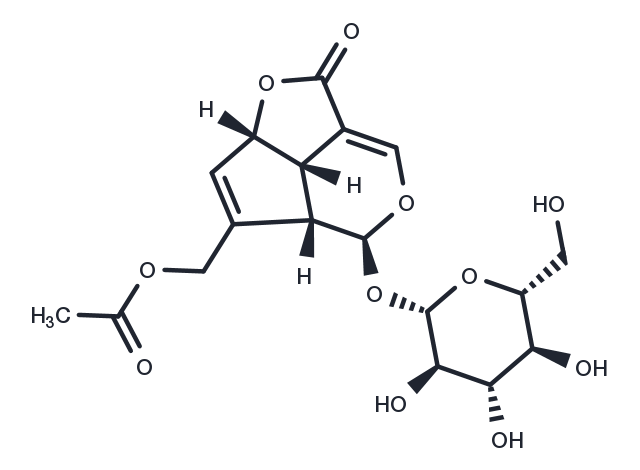Powder: -20°C for 3 years | In solvent: -80°C for 1 year


Asperuloside (Asperulosid) has anti-inflammatory activity.

| Pack Size | Availability | Price/USD | Quantity |
|---|---|---|---|
| 5 mg | In stock | $ 55.00 | |
| 10 mg | In stock | $ 97.00 | |
| 25 mg | In stock | $ 185.00 | |
| 50 mg | In stock | $ 276.00 |



| Description | Asperuloside (Asperulosid) has anti-inflammatory activity. |
| Kinase Assay | The chemiluminescent assay is used to confirm PCSEE MAO-A and MAO-B inhibitory effects and to test BNN and BVN hMAO-A and hMAO-B inhibition using MAO-Glo kit. Each enzyme's Arbitrary Light Unit (ALU) is measured in the presence of PCSEE, BNN, BVN, and standard DEP as an MAO-BI positive control. Briefly, hMAO-A and hMAO-B isozymes are diluted to 2× with reaction buffer (pH 7.4) and preincubated with 4× PCSEE, BNN, BVN, or DEP working solutions at RT for 30?min in white opaque 96-well plates. For determining activity inhibition, final 8.5?μg/mL concentrations of PCSEE, BNN, BVN, and DEP are used. For IC50 determination, 8× PCSEE and BNN working solutions are serially diluted using reaction buffers (pH 7.4) to make a 4× concentration. Ten points' range of PCSEE (1.0 to 250.0?μg/mL) and BNN (up to 400?μM (135.4?μg/mL)) final concentrations is used. Controls used are with and without ethanol. Ethanol solvent in controls is kept to a maximum final (volume) of ≤2%. Each isozyme is substituted with the reaction buffer for the blank. Based on our preliminary optimizations and Valley's method, the reaction is initiated by adding 4× luciferin derivative substrate (LDS) for a final (concentration) of 40 and 4?μM for hMAO-A and hMAO-B reactions, respectively. The final volume per well of each reaction is 50?μL. The reaction is optimized for the amount of A and B enzyme used to be incubated for less than 3.5?h at RT. To stop the reaction and produce the luminescence signal RLDR is added to all wells, 50?μL to each well, and incubated for a further 30?min. |
| Source |
| Synonyms | Asperulosid |
| Molecular Weight | 414.36 |
| Formula | C18H22O11 |
| CAS No. | 14259-45-1 |
Powder: -20°C for 3 years | In solvent: -80°C for 1 year
DMSO: 60 mg/mL (144.8 mM)
You can also refer to dose conversion for different animals. More
bottom
Please see Inhibitor Handling Instructions for more frequently ask questions. Topics include: how to prepare stock solutions, how to store products, and cautions on cell-based assays & animal experiments, etc.
Asperuloside 14259-45-1 Immunology/Inflammation Others NO Synthase Inhibitor NOS Nitric oxide synthases Asperulosid inhibit inhibitor
